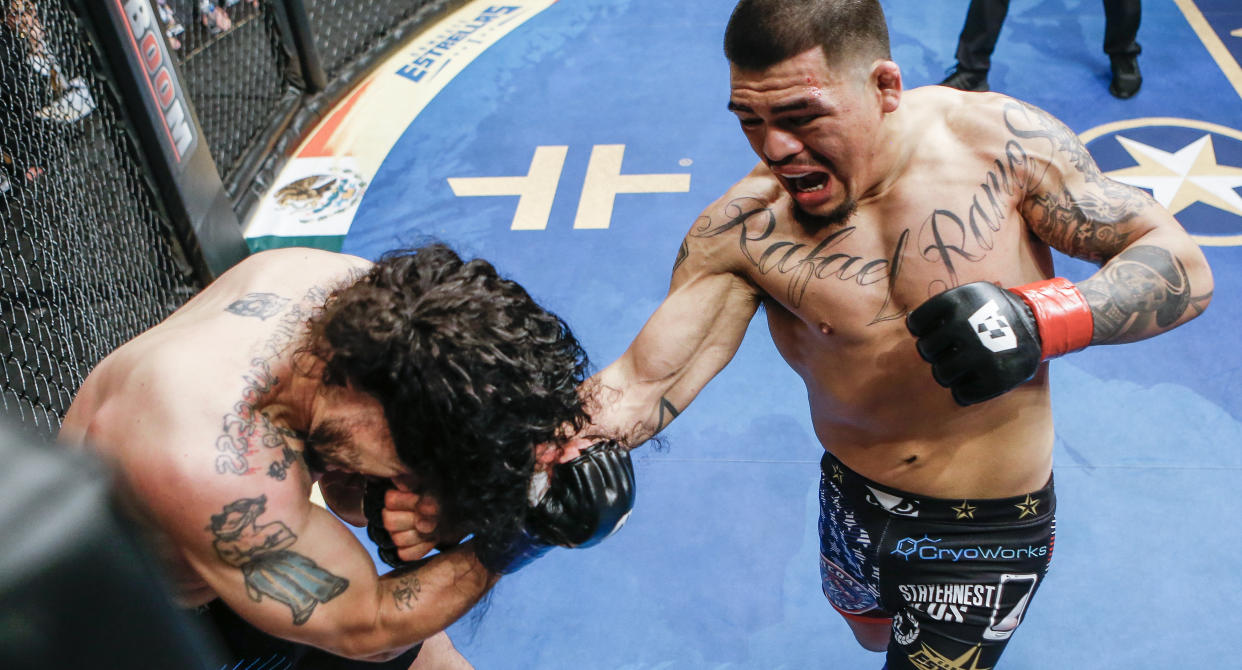Upstart MMA promotion Combate Americas is finding success in a UFC/Bellator world

The numbers didn’t need translation.
On the night of April 13, Bellator 197 drew a combined 403,000 viewers between the Paramount Network and CMT, for an event from St. Charles, Missouri, which aired live in prime time in most of the country.
Combate Americas, by contrast, drew a combined audience of 764,000 on Univision and Univision Deportes for its live, Spanish-language telecast from Los Angeles on the same evening, despite the fact the main card aired after midnight Eastern.
Not only did Combate’s numbers nearly double the figures produced by Bellator, the Viacom-backed promotion which is widely acknowledged to be North America’s No. 2 mixed martial arts promotion, but it’s also a better rating than some of the lower-end offerings from the industry-leading Ultimate Fighting Championship: The June 1 UFC Utica card, headlined by Marlon Moraes vs. Jimmie Rivera, averaged 512,000 viewers with a peak of 593,000.
Now, we’re not here to say that the upstart, Latino-themed MMA promotion is about to unseat the UFC or Bellator on a regular basis any time soon.
But if a fight outfit which has only put on a handful of shows in the United States has already reached the point where their bigger offerings produce numbers comparable to and in some cases better than the sport’s long-established titans, then isn’t there something to be learned about the state of MMA promotion in 2018?
Combate Americas co-founder and senior vice-president Mike Afromowitz believes the future of the sport is in catering to under-served segments of the audience, and that Combate is uniquely positioned for growth in their market.
“There are millions and millions of Hispanic households in the U.S.,” Afromowitz said. “They’ve proven their passion for combat sports over the years. And that’s before we even start talking about Latin American countries. The other companies only get to Mexico every so often. We’ve made a conscious effort to reach out to those markets and we’re starting to see those markets respond in a big way.”
We’re in a period in which the U.S. MMA market is just about flooded with product. The UFC is planning on running about 40 events this year, a number expected to increase to 47 next year, when its broadcast partner switches from Fox to ESPN. Bellator’s momentum has leveled off, as its television ratings have stalled.
Into that environment comes the new Professional Fighters League, which is questionably proclaiming it will offer million-dollar prizes to competitors; and the MMA Pro League, an attempt at rehashing a team MMA concept, which was a spectacular failure as the International Fight League in 2005-07.
But while mainstream MMA appears to be barreling toward another bubble burst, promoters who instead target specific audiences are finding success. The Poland-based KSW, for example, has grown to the point last year’s KSW 39 drew 57,776 spectators in Warsaw, using Polish fighters in 10 of the top 12 slots.

Combate Americas, which put on its first event in 2014, has a ways to go to match KSW’s success, but the point remains: Cater to the audience by using fighters with whom they identify, and eventually, they’ll come around.
Further proof Combate Americas’ ideas are gaining traction come from their television ratings in Mexico, where it airs on Azteca 7. Combate’s four April and May events on the network averaged 3 million viewers, compared to the 2.7 million averaged by popular lucha libre promotion AAA on Televisa. Combate’s deal with ESPN Latin America now carries the product into 21 Spanish-speaking countries.
This growth begs the question why Combate Americas hasn’t gotten more attention in the English-language media. Part of it is simply a matter of distance: About half of Combate’s couple dozen shows to date have been held in heavily Hispanic locales in California, Arizona and Texas, but most of the rest have been held in Mexico.
And yes, part of the lack of coverage is simply the language barrier. Mexican soccer matches can push Univision to ratings that beat the major English-language networks on the day, for instance, but the matches themselves don’t get much space in the American sporting press.
Afromowitz acknowledges this, and says expanding their English presence is on their radar.
“It’s first things first,” Afromowitz said. “We’re still building this out in our core areas. Eventually we’re going to get around to building the brand on the English side, but we’re still in the process of ramping up the product for our core audience and markets.”
That’s where Combate will leave off at the moment. Their May 18 card in Tijuana was the final event before a summer break, as the promotion will step aside while World Cup soccer dominates the Hispanic sports landscape. But they’ll return in August with a soon-to-be-announced slate of events.
And if this spring’s television numbers are any indication, the promotion can no longer be brushed aside, no matter which language you speak.
More from Yahoo Sports:
• Charles Robinson: Kap’s legal team looks to turn tables on Trump
• This might be the craziest blooper in MLB history
• Dan Wetzel: Cavs have totally wasted the LeBron era
• Chris Mannix: Are the Warriors taking the fun out of the NBA?


